Choosing the Best Rifle
for Pronghorn Antelope
By Randy Tucker |
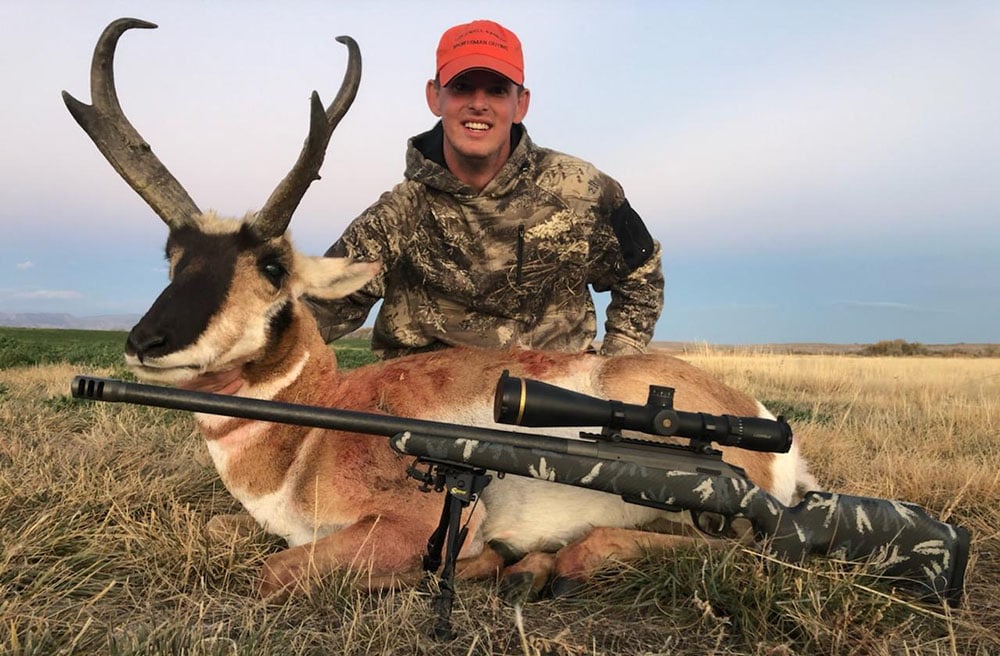
Hunting pronghorns is different than any other big game species. Selecting the best rifles for pronghorn doesn’t have the same parameters other big game species follow, but there are a few important aspects you must consider. The first is that the rifle must be accurate at a minimum distance of 400 yards. You could find yourself with longer shots in the vastness of the pronghorn’s range, so energy over distance, and accuracy are the two most important considerations in finding the best rifle for pronghorn hunting.
Spotting a herd of pronghorn is a sign that you’re leaving the short grass prairie and moving into the high desert, and foothills of the Rockies on any westbound route you take across the Great Plains. The white rump, against the tan hide, is an iconic image of the west. The pronghorn, "ikpísaŋla" in the Lakota language are denizens of the desert. You can find them on the western edge of Kansas, Nebraska, and North and South Dakota, with the heaviest populations in Wyoming, and substantial herds in Montana, Colorado, Utah, Arizona, New Mexico, Idaho, and the eastern reaches of Oregon and Washington. In many ways, they are more of an image of the west than the horse.
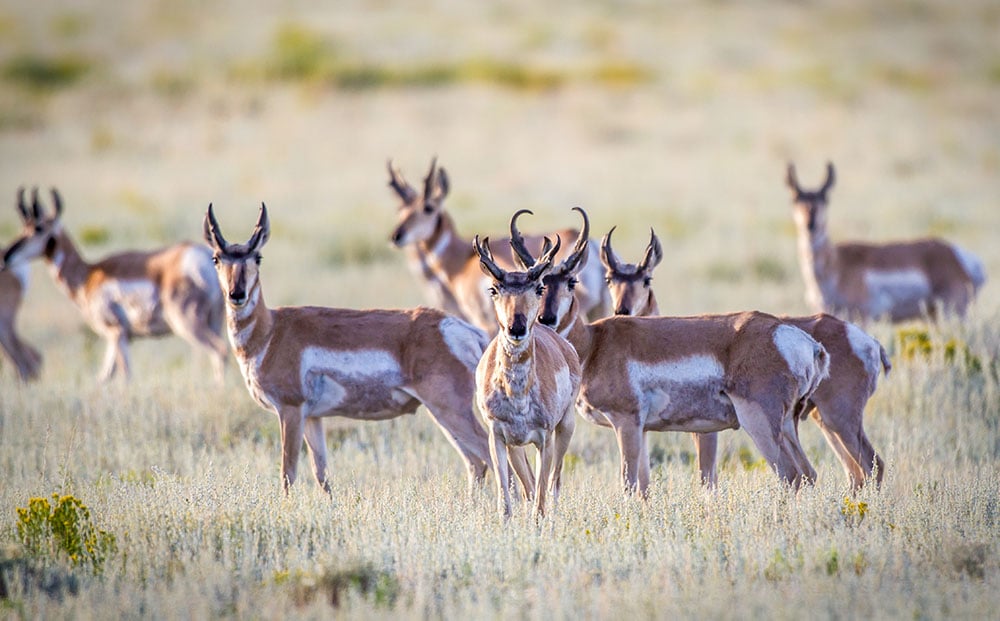
Pronghorn, along with whitetail deer are the smallest big game in North America. Often mistakenly called antelope, they are more accurately described by one of the most common terms among western hunters, “speed goats.” Fast is what they are, the second-fastest land mammal on the planet after the African cheetah. Antelope with speeds measured in excess of 60 miles per hour in short sprints. As a smaller game animal, you won’t need a pronghorn rifle in large caliber, but instead need to find one that offers a flat, accurate bullet at long range with the 1,000 pounds of energy necessary for an ethical shot.
Antelope don’t have antlers as deer, moose, and elk do, but horns. Trophy hunters look for bucks with horns at least 15 inches long, which are rare. Most bucks have horns from 12 to 14 inches. Hunting these skittish, high-energy speed demons is a challenge. There are several methods of hunting pronghorn, and each one requires a different style of rifle.
Pronghorn Hunting Techniques
There isn't just one technique for hunting pronghorn. The techique you choose will determine the gun you'll want for your hunt.Long Range Shooting
The vast distances of typical pronghorn habitats can be daunting for some hunters. Pronghorn are easy to spot, running in herds from a few dozen to more than a hundred. Each of these herds will have a dominant buck, with his harem and a few smaller bucks tagging along. Some of those smaller bucks may have larger horns than the dominant male, but their body size will be smaller. It’s a great idea to glass over a distant herd of pronghorn before beginning your approach.
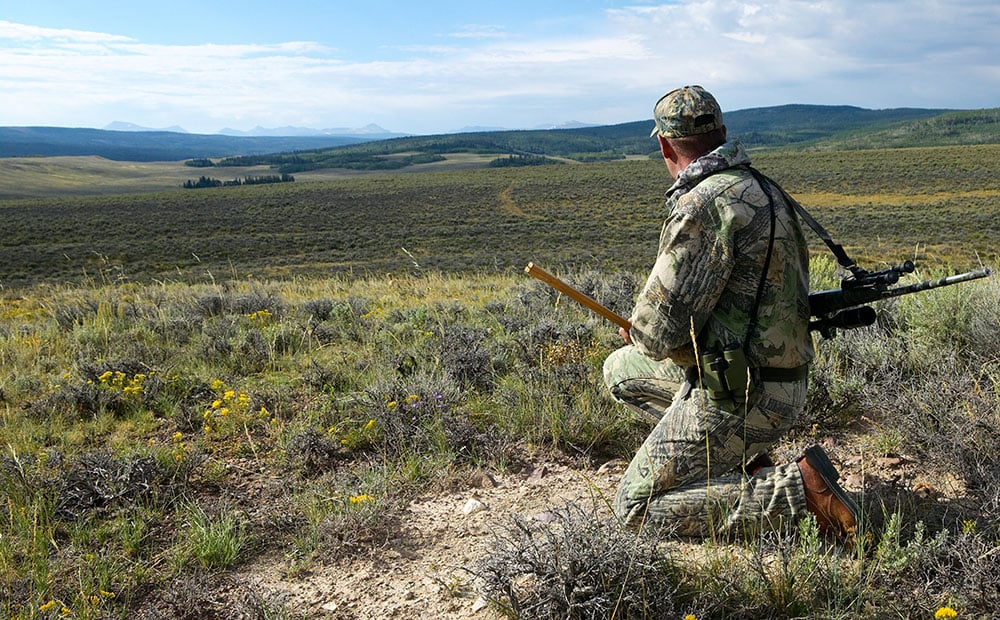
Pronghorn don’t require the massive shock needed to ethically take a large mule deer, elk, or moose, but it’s still a good practice to deliver 1,000 pounds of energy on the target. To do that at distances beyond 400 yards requires a cartridge beginning with the 75-grain version of the .243 Winchester, and moving up from there in caliber.
In recent years, the 6mm and 6.5mm Creedmoor have risen to prominence among many pronghorn hunters. I used my Remington .308 for decades in taking pronghorn but would not take shots beyond 250 yards with it due to a shorter barrel length on this rifle. Beginning five years ago I borrowed my son’s 6.5 Creedmoor and took a nice 14 ¾ inch buck at 445 yards in an alfalfa field in Central Wyoming. He has taken bucks at almost 600 yards with this rifle.
Flagging
It sounds like another western story, akin to “Jackalope” hunting, but flagging pronghorn is a practice that dates back thousands of years with Native American hunters.
Antelope are inquisitive. With their incredible speed, they can outrun any predator aside from an eagle easily. If something is out of the ordinary in their environment, they’ll move in for a closer look. Native American hunters, and modern hunters as well, can get antelope to move within 30 yards by randomly waving a white flag above the sagebrush. The key is to remain out of sight, downwind, and silent as you wave the flag. They’ll move in close to see what’s going on. If you’re good at it, you might even get the does to stamp their feet and bleat at you in an attempt to drive off that white flag.
The advantage of this technique is obvious, you’ll get very close shots. The final step in moving from flag to rifle has to be quick or they’ll rip across the prairie in 0 to 60 in just a few strides and all you’ll see is white rumps racing away. This technique is best done with a partner. One person will flag, while the other sights on the buck of choice before firing.
A .243 works well flagging with the close range shots you’ll get, but a .308, .270 or 6.5 Creedmoor delivers a quality shot on target as well.
Blinds
They work great in duck hunting, and even better when placed against an embankment near a harvested grain field, and they work well in pronghorn hunting too. Bow hunters prefer using blinds when chasing pronghorn but it’s a great technique for rifle hunting as well.
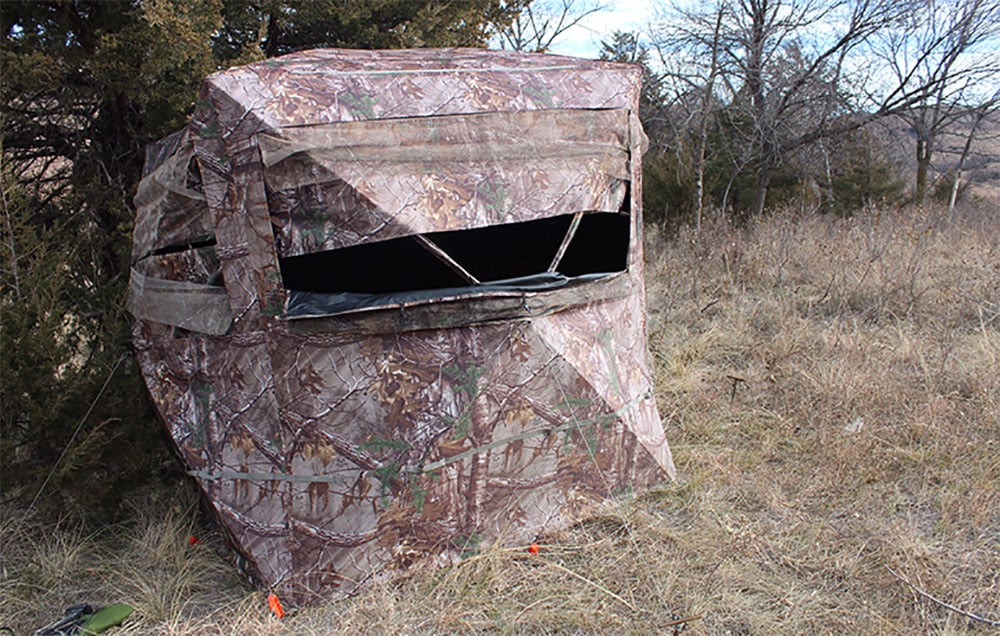
Select a spot adjacent to a water hole or along a game trail and set your blind accordingly. It should match the surrounding terrain, blending in with brush, thickets, or small trees. You might wonder why people don’t just set up a tree stand in the same area, the answer is, this is the west, good luck at finding a tree big enough for a stand adjacent to a likely hunting spot. There are a few areas where this would work with a large cottonwood tree, but it’s not a good choice in hunting styles.
With a blind, you can see the pronghorn approach, and simply wait to get the one you want. This takes patience and luck. Pronghorn have excellent senses, they see, hear and smell much better than we can and the slightest whiff of human scent will send them scattering across the sagebrush. With a blind, any caliber larger than a .223 will work but check local game codes to make sure this is a legal cartridge. In many states, the smallest big game rifle allowed by statute is the .243.
While barrel length is important in long distance shooting, it’s not as important in flagging distances, where almost any variety of rifle in a caliber above .243 will drop a pronghorn instantly with a well placed shot. Closer shots mean greater energy when the bullet arrives, and less chance for a poorly placed shot.
Hunting from a blind and flagging are vastly different techniques, but at crunch time the shot is the same, a close range, high energy flash that drops an animal instantly. A .243 works just fine, from a blind, but almost any caliber works well.
A Story from a Blind
I’d taken several dozen mule deer over the last few decades, but my first whitetail buck came in November of 2019 on an 18 below zero morning. We scouted the area before the season opened and spotted a pair of nice 5x5 bucks running with a herd of about 50 does and smaller bucks. My friend Trapper had a tent style lightweight blind that we set up a couple of days before. We had folding stools inside the blind and set the shooting windows to the west and southwest in the direction we’d seen the herds move into the area from a nearby alfalfa field each morning. Just five minutes after legal shooting hours opened, the herd moved in. We could barely see each other inside the blind but communicated with signs and gestures. At 180 yards, I pulled the trigger on my 788 Remington .308 and my hunt was over. We walked over, and I tagged one of those nice, forward point 5x5 bucks. But it took silent patience.
Rifle Type
Selecting a rifle for pronghorn hunting isn’t that difficult. The first question you have to answer is how you plan to hunt. If you’re going to drive along two-track roads, stop, glass an area and then keep moving until you find a herd, you’ll be long distance shooting. This is the most common method employed by hunters.
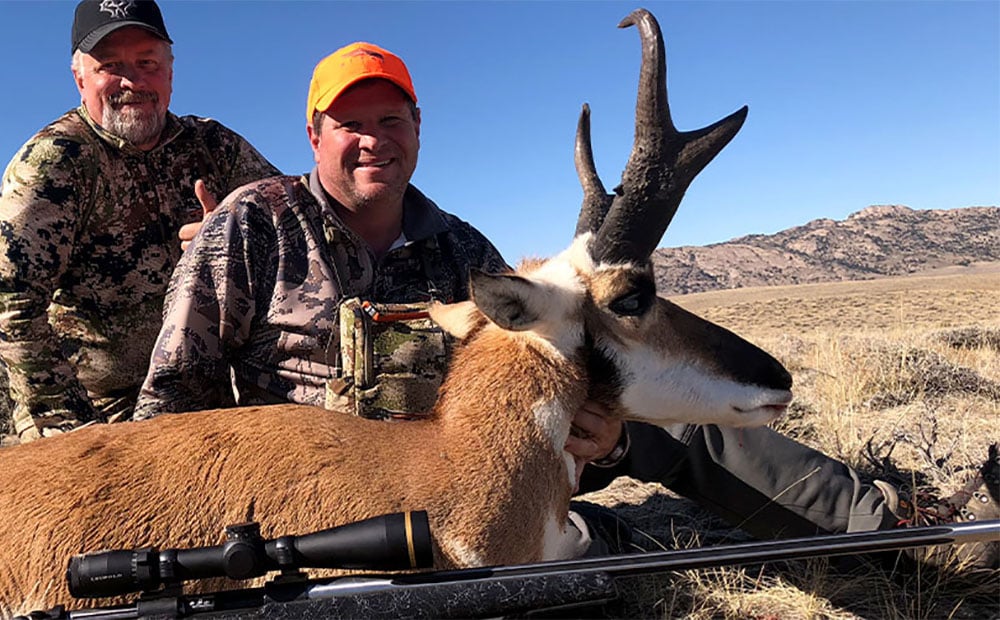
If you’ve done your homework, scouting an area for a few weeks prior to the season opening, you’ll most likely have a game plan in mind already for opening day, and a long distance rifle won’t be as important consideration since you’ll be moving up slowly while stalking the herd. That’s also true if you’re planning on flagging or hunting from a blind.
Let’s look at what you’ll need for both styles of hunting:
Long Range
You often hear the term “flat shooting.” What that means is a cartridge that is on target at 200 yards. Almost all modern big game cartridges are now “flat” at 200 yards. In the case of pronghorn hunting all the popular calibers, .243, 6mm, 6mm Creedmoor, 6.5 Creedmoor, .25-06, and the .270 are flat at 200 yards. The difference between these various calibers begins gradually at 300 yards where all of them start to drop and extends to 500 yards where the drop is substantial. Bullet drop doesn’t mean you can’t hit a target at that range, it just means you must compensate for the drop with your scope. Instead of shooting straight, or flat at 200 yards, the bullet must take a slight arc to the target at greater distances.
Barrel length is important in long distance shooting. The longer the barrel, the more accurate the shot. A 22-inch barrel is standard, but a barrel length of 24 or 26 inches can give you an advantage on long shots.
Targeting an animal for an ethical heart/lung shot is the first part of the equation, delivering that thousand pounds of energy at range is the other. The .243 drops below the 1,000 threshold beyond 300 yards in every variety of ammunition, while the other calibers mentioned above all retain enough energy for an ethical kill at 500 yards, with many extending beyond that distance.
| Caliber | Drop at 300 Yards (in) | Energy at 300 Yards (ft-lb) | Energy at 500 Yards (ft-lb) | |
|---|---|---|---|---|
| .243 | 4.9 | 1189 | 775 | |
| 6mm | 6.1 | 1261 | 835 | |
| 6mm Creed | 6.6 | 1446 | 1106 | |
| 6.5 Creed | 6.3 | 1841 | 122 | |
| .25-06 | 6.4 | 1502 | 1031 | |
| .270 | 5.7 | 2229 | 1417 | |
Estimating Distance
If a pronghorn is within 200 yards, you don’t need to measure the distance. If your rifle is sighted in at 200 yards it will shoot flat at that distance, and rise only a half to two inches at closer distances. That’s accurate enough for a clean, ethical kill every time.
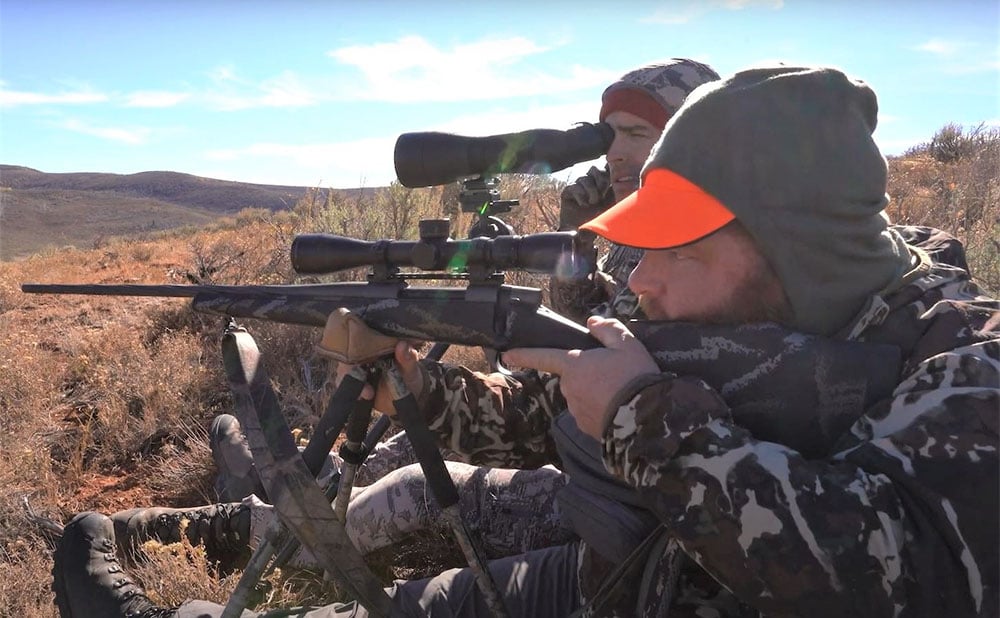
Correctly estimating the distance of the pronghorn antelope is extremely important. Many hunters miss their targets because they assume they are much farther away, and shoot over them. If you are concerned about estimating distance, determine the actual distance with a laser rangefinder. Knowing the distance to the antelope, along with the bullet drop of the cartridge you’re shooting will allow you to adjust your sight accordingly.
Caliber
You read a lot about caliber already in the long range shooting section above. Pronghorn are not massive animals, if they were they wouldn’t be able to move at 60+ miles per hour, but they are as large as most whitetail deer. Smaller bucks tip the scales at 100 pounds, but the bigger ones in a herd can reach 150 pounds.
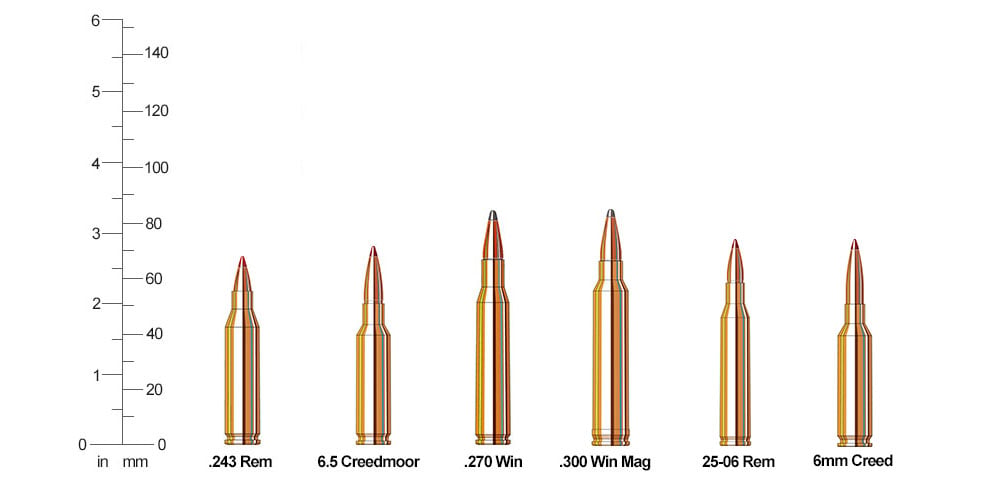
With the smaller size of the animal, the caliber, energy, and bullet size are not as important, but you should still adhere to the 1,000 foot pounds of energy principle. One shot, one kill has always been the mantra of the best hunters I’ve known, and we all should try to match that concept when we pull the trigger.
Any caliber over .243 can ethically drop a pronghorn at ranges less than 200 yards. If you’ve got a close range shot in the open, taking one from a blind, or have attracted a buck while flagging, any standard cartridge beginning with .243 and extending to .308 will do the job. Larger calibers are equally effective, but the slightest miss with a heavy bullet, fired at high speed will destroy the meat in either shoulders, or the rear end, creating a mess that isn’t edible. Small to mid-size cartridges are best for pronghorn. Save your .375 Ruger and .338 Lapua for elk, deer, and bison.
A look at the extensive ballistics chart created by Hornady reveals hundreds of calibers to choose from. We could go through those one by one to rate the relative merits of each one, but with so many mainstream, and niche cartridges available today it’s not necessary. You just need to determine where the rifle cartridge you’re looking for in a gun that feels good to you fits on a chart, check the ballistics, and then move on.
| Caliber | Bullet Size (gr) | Bullet Drop at 400 Yards | Energy at 400 Yards | |
|---|---|---|---|---|
| .243 | 80 | 17.1 | 852 | |
| 6mm | 95 | 18 | 980 | |
| 6mm Creed | 108 | 18.9 | 1031 | |
| 6.5 Creed | 120 | 20.5 | 1241 | |
| .25-06 | 117 | 20.7 | 1249 | |
| .270 | 130 | 18.6 | 1488 | |
| .308 | 150 | 23.1 | 1338 | |
A Few Good Choices for a Pronghorn Rifle
You may have heard that barrel length is the biggest feature in how accurate a long range rifle can be. That’s not entirely true. A longer barrel is necessary for some heavier caliber cartridges since the extra length allows the larger powder charges to fully ignite. A longer barrel will produce slightly faster velocities in every caliber, on the scale of 30 to 50 FPS when comparing a 22-inch barrel to a 24-inch variety. Some say that a 22-inch barrel caps out at 400 yards, but that isn’t the case. Let’s look at a few good rifles for pronghorn hunting.
Ruger American

An inexpensive rifle, from a world leader in quality firearms, what more could you ask for? The American is offered in .243, 6.5 Creedmoor, .308, and .30-06. The .30-06 is a little bit of overkill for a pronghorn rifle, but the other three calibers, particularly the American in .243 or 6.5 Creedmoor are outstanding guns.
They all feature a four round internal magazine and weigh around 6.2 pounds which makes them light enough to carry for a while, but heavy enough to reduce the lighter recoil of a .243 or 6.5 Creedmoor to barely discernable levels.
Produced in a black 22-inch barrel with a durable all weather black composite stock, these rifles are accurate. They deliver a .243 on target with over 1,000 pounds of energy at 350 yards, and in the 6.5 Creedmoor, you’ve found a rifle that can deliver an ethical kill shot at 600 yards.
Savage Arms 110 Hunter

With a synthetic Accustock with aluminum bedding for additional support plus Savage’s renowned Accutrigger, this is a great rifle for all around use. It’s capable of accurate long distance shots but it’s quick enough for those close range pronghorn bucks as well.
Drilled and tapped so it’s ready to mount a scope out of the box. It is available in a wide variety of calibers but for our purposes, we’ll just list the .243, 6.5 Creedmoor, and the venerable .270. The .243 and .270 have a 22-inch barrel, while the Creedmoor comes with a 24-inch barrel. That extra two inches combined with the performance of the popular 6.5 Creedmoor cartridge delivers outstanding accuracy at a very long distance.
The Hunter has an external four round magazine
Browning X-Bolt Western Hunter

Sometimes manufacturers show their hand in advertising. That’s the case with Browning’s Western Hunter. The name brings images of stalking big game across the vastness of the west, and this rifle is specifically designed for those long shots across the open plains, and foothills of the Rockies where pronghorn thrive.
The Western Hunter is only available in 6.5 Creedmoor and 6.5 PRC. We’ve reviewed the Creedmoor cartridge already, so we’ll concentrate on the Hunter offered in that caliber.
The stock has a camouflage pattern, the barrel is threaded with a muzzle brake, and the rifle arrives with Browning’s adjustable Feather Trigger System. The unique detachable rotary magazine is an innovation that mixes the ease of loading ammunition in an external magazine, with the style of a smooth stock devoid of what many consider an unsightly addition to a hunting rifle.
The 6.5 Creedmoor version comes with a blued steel, 24-inch barrel, and weighs just 6.14 pounds, making it well balanced between the need for enough heft to reduce recoil, and a light enough weight to pack easily on long treks in pursuit of game.
Scope
Hunting pronghorn on the open ground where they live will require some of the longest shots you’re ever likely to take in big game hunting. The days of the adjustable iron sight or the slightly improved peep sight are gone. All hunters now rely on high quality optics to target and take big game. In the case of pronghorn, which represents a smaller profile than mule deer, elk, moose, or bison, your aim is a critical component of an ethical, successful hunt.
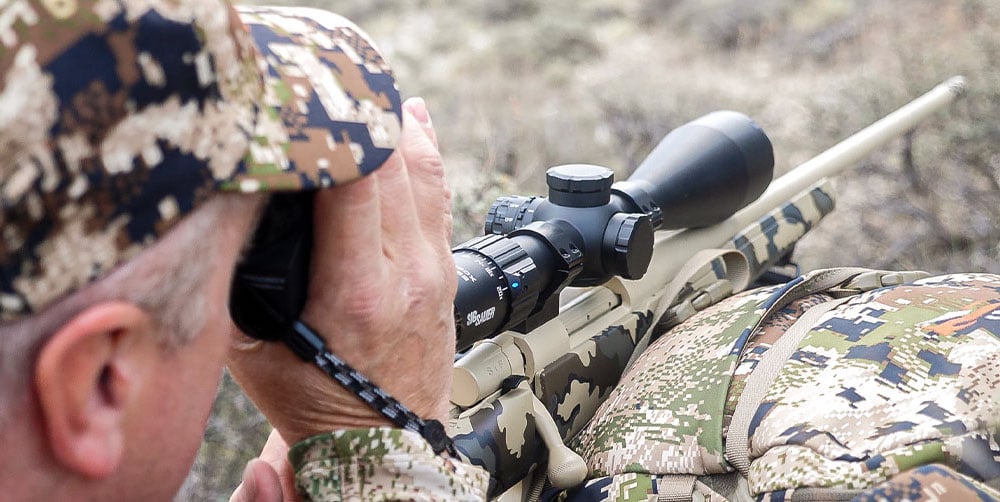
Fixed power scopes are fine for varmint hunt with lower powered centerfire or rimfire ammunition, but a variable power scope is an important consideration when pronghorn hunting.
Clear, crisp optics, with bright crosshairs visible in the violet light of early morning or late afternoon, are a necessity. As a hunter, you need to worry about your scent signature more than the direction of the morning or afternoon sun when it’s low on the horizon. A scope that can handle bright sunlight without blinding you is another consideration.
Graduated marks on the vertical axis of your scope crosshairs aid in accurately targeting a distant pronghorn once you’ve calculated the distance with a range finder. You’ll need time on the shooting range to be adept enough at long distance shots to successfully use those distance marks as you elevate your rifle along the cross checks that indicate 100-yard increments past the standard 200 yards of the center point of your scope.
These animals are denizens of the plains. In the early 19th century you could find antelope in the high scrub conifers and in lodgepole pine and spruce forests. The plains were inhabited by elk, but man forced the two to switch biomes, and today, you won’t need a rifle, scope, or cartridge to shoot through the timber. Speed goats are always on open ground.
Marksmanship
Hitting what you aim at is essential in every style of pronghorn hunting. You might have a close shot at 75 to 200 yards, but you still have to have the skill to hit a 6x6 inch target that outlines the vital heart and lungs of a buck. If the buck is running, just put your rifle down, and wait for another opportunity.
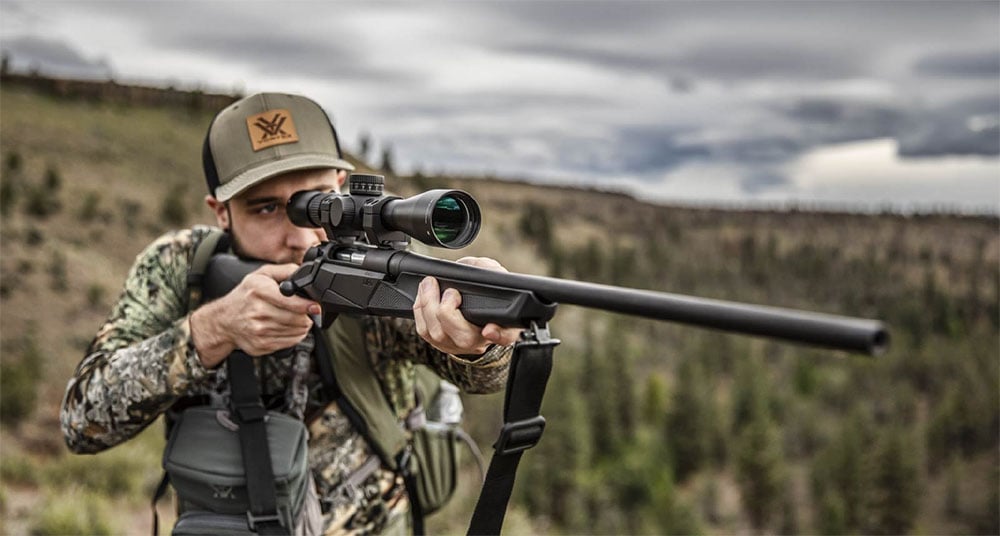
At greater distances, you’ll need a steady rest to fire from such as a corner post on a barbed wire fence, bipods on your rifle from a prone position, or X-style shooting sticks for a standing shot. A rifle locked into place, with a gentle squeeze on the trigger remains the best marksmanship skill there is.
Aligning your shot with your breathing is also important, but aside from a few Zen practitioners, or maybe a stray Jedi knight, you’re not going to be able to align your shot with your heartbeat. (No matter what you may have read)
At the end of the hunt, you want to squeeze the trigger once, watch the animal drop instantly with a single shot. That’s an ethical hunt, and ethical hunting demands accurate marksmanship.
In Conclusion
Pronghorn represent a unique challenge to the big game hunter. You don’t have to track them like deer or elk. You don’t have to climb tall mountain peaks as you do with sheep and goats, and many consider pronghorn hunting, pronghorn shooting, rather than facing the challenges the other North American big game species present.
Pronghorn hunting is a sport that requires greater marksmanship skills in a quicker framework than any other animal. These guys are fast, incredibly so to us slow footed humans.
Here is a final story about pronghorns. In Wyoming, deer, pronghorn, elk, and even moose regularly move into small towns at night to graze in the parks and on the local football field. I was coaching track and field one spring, and we had a meet 100 miles away that morning in Dubois. We had to get the kids on the bus by 5 a.m. for the trip. It was pitch black as I walked across the football field to get some starting blocks from our equipment shed. As I walked back I sensed there was something close by, breathing heavy. It was a strange sensation but I couldn’t spot anything against the backdrop of the neighboring house lights until I tripped over a pronghorn. A doe I guessed by its size. As I steadied myself I heard two or three dozen pronghorn spring to their feet and instantly they took off at full speed. Thankfully I’d kicked one on the outer edge of the herd. I froze as a couple raced within inches of me. They have better night vision than I did and none of them hit me. As I walked back to the bus several of the boys said, “Hey coach, did you see those antelope?” “Yes,” I said. “Up close and personal.”